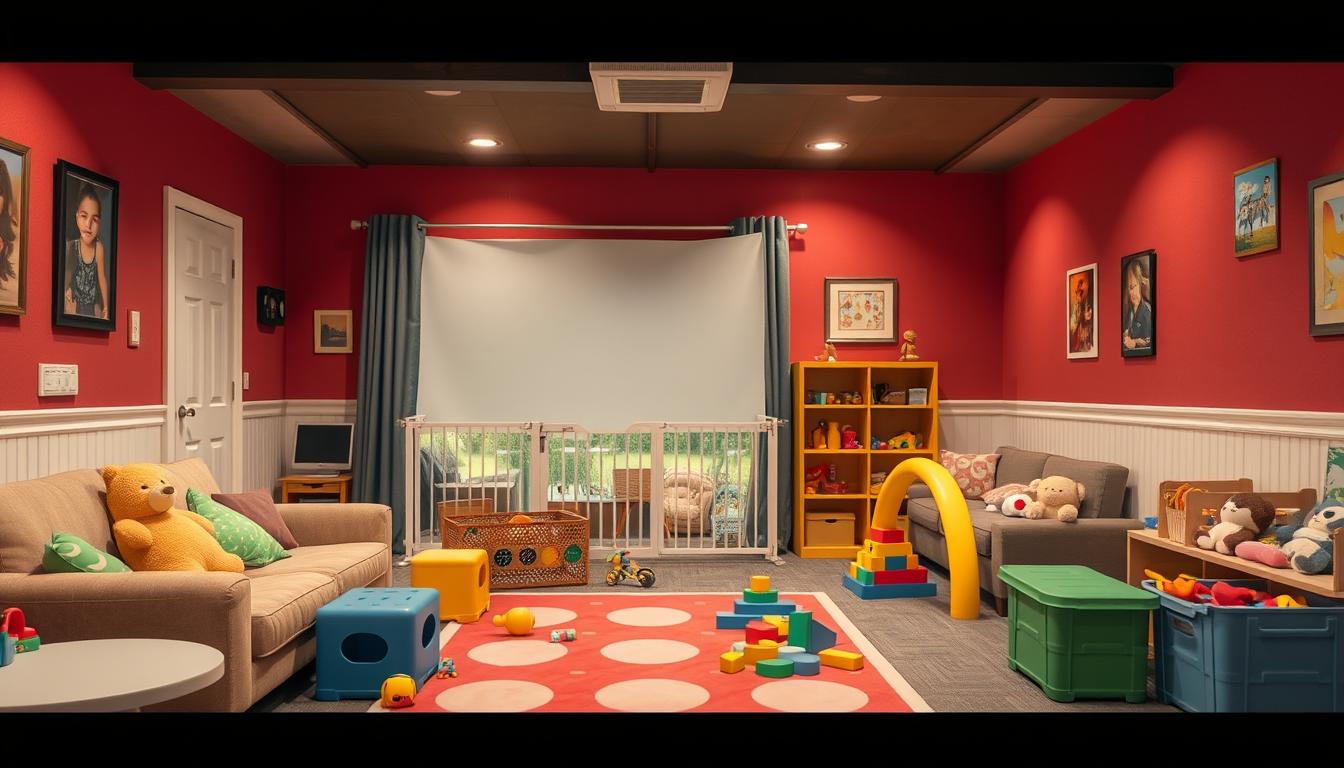As a parent, I want to make sure my kids are safe and sound at home. I’m sure you feel the same way. To do this, it’s key to learn how to childproof your home. In this article, I’ll share my best tips to help you keep your little ones safe.
It’s vital to understand the importance of childproofing and home safety for kids. By taking these steps, you can lower the risk of accidents and injuries. I’ll show you how to spot dangers and make your home a safe place for your kids to grow and learn.
I’ll give you practical advice on making your home safer for kids. This includes simple changes and bigger renovations. By following my tips, you can create a safe space for your kids to play, learn, and grow. You’ll learn how to use effective childproofing tips and home safety measures.
Assessing Potential Hazards in Every Room
As a parent, it’s vital to check for hazards in every room. This makes our home safe for our kids. We need a detailed checklist for this. It should include installing safety gates, especially near stairs or dangerous materials.
Having a good babyproofing plan is key. It helps avoid accidents and lets our kids play safely. By looking at each room’s unique features, we can spot dangers and fix them.
Living Room Safety Checks
In the living room, we must secure heavy furniture and appliances. This stops them from falling over. We should also use safety gates to block off areas like the kitchen or stairs.
Kitchen Precautions
In the kitchen, we must keep cleaning supplies and sharp objects out of reach. Safety latches on cabinets can also prevent accidents.
Bathroom Dangers
In the bathroom, dangers include slipping on wet floors and hot water. Simple steps like using non-slip mats and safety locks on faucets can make it safer for our kids.
Bedroom Considerations
In the bedroom, we must ensure a safe place for our kids to sleep. We should store toys and clothes safely. Following a detailed childproofing checklist and using babyproofing ideas helps prevent accidents and makes a secure space for rest and play.
Childproofing Your Home Effectively
As a parent, making your home safe for kids is key. Childproofing your home is crucial for your child’s safety. A few simple steps can greatly reduce accident risks in your home.
First, check your home for hazards. Secure furniture like bookshelves and TVs to prevent them from falling. Use childproofing products like straps and brackets to keep heavy furniture and appliances stable.
Installing Safety Gates
Next, install safety gates at stairs and in front of hazardous rooms. These gates can be mounted with hardware or pressure. Choose what works best for you.
Securing Furniture and Appliances
Securing furniture and appliances is also vital. Use safety latches and outlet covers to block access to dangerous areas. This keeps your kids safe from harm.
- Use furniture straps to secure heavy furniture and appliances
- Install safety latches on cabinets and drawers
- Use outlet covers to prevent electrical shock
By following these steps and using childproofing products, you can make your home safe for your kids. This allows them to grow and thrive in a secure environment.
Creating Safe Outdoor Spaces
As a parent, I want my kids to enjoy the fresh air and sunshine. I make sure they play safely outside. Installing fencing and boundaries is key to keep them from wandering off.
Pool safety is also a big deal. Fences and alarms can stop drowning. Keeping lawn mowers and other dangers out of reach also helps avoid accidents.
- Install fencing and gates that are at least 4 feet tall to prevent kids from climbing over
- Use pool alarms and fencing to prevent accidental drowning
- Store outdoor equipment and hazardous materials out of reach of children
| Outdoor Safety Measure | Description |
|---|---|
| Fencing and Boundaries | Prevents kids from wandering off and reduces the risk of accidents |
| Pool Safety Measures | Prevents drowning and ensures kids’ safety around water |
| Outdoor Equipment Safety | Prevents accidents and injuries from hazardous equipment and materials |
By using these safety steps, you can make your home safe for kids. It’s all about keeping them safe and happy outside.
Proper Storage of Dangerous Items
As a parent, keeping your home safe is crucial. This includes storing hazardous materials properly. Home safety measures can greatly lower the risk of accidents and poisoning. One key part of this is keeping medications and cleaning supplies in the right place.
Medications and Cleaning Supplies
These items need to be stored where kids can’t get to them. Use locked cabinets or high shelves for this. This simple step can help prevent accidents and keep your home safe for your kids.
Tools and Hardware
Tools and hardware should go in a special place, like a toolbox or shed. This keeps sharp objects and other dangers out of kids’ reach. By following these tips, you can make your home a safer place for your children.
Some examples of proper storage include:
- Storing sharp objects in a locked cabinet or on a high shelf
- Keeping medications and cleaning supplies in a secure location
- Using a toolbox or shed to store tools and hardware
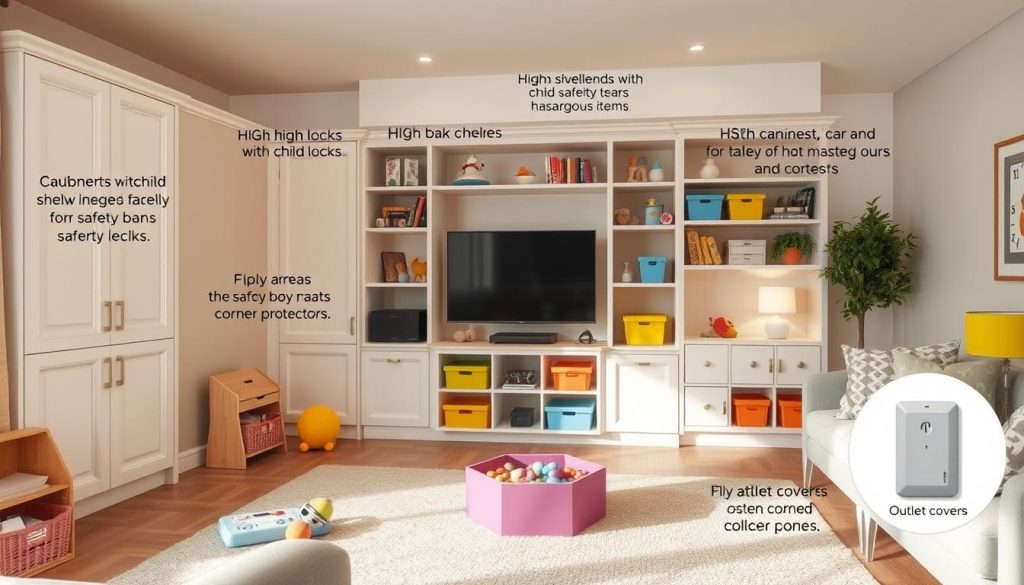
By taking these steps, you can make your home safer for your kids. Always follow childproofing tips and take precautions to avoid accidents. This way, you can ensure a happy and healthy home for everyone.
| Item | Storage Location |
|---|---|
| Medications | Locked cabinet or high shelf |
| Cleaning Supplies | Locked cabinet or high shelf |
| Tools and Hardware | Toolbox or shed |
| Sharp Objects | Locked cabinet or high shelf |
Understanding Fire Safety for Kids
As a parent, making fire safety a top priority is crucial. This means installing smoke detectors and alarms in every room. Especially in places like the kitchen where fires can happen.
Keeping electrical safety in mind is also key. It helps prevent fires and electrical shocks. Make sure cords and appliances are out of reach and don’t overload outlets.
Smoke Detectors and Alarms
Smoke detectors and alarms are vital for alerting us to fires. It’s important to test them every month and change the batteries once a year.
Fire Escape Plans
Having fire escape plans is essential. They help us leave the house quickly and safely. Identify at least two ways out of each room and pick a meeting spot outside.
Electrical Safety
Electrical safety is crucial. Keep cords and appliances away from kids and avoid overloading outlets. Use cord protectors and avoid damaged cords.
By following these tips, we can make our homes safer for our kids. This ensures a secure environment for them to grow and thrive.
| Fire Safety Tips | Description |
|---|---|
| Install smoke detectors and alarms | Alerts us to potential fires |
| Create fire escape plans | Helps us evacuate the house quickly and safely |
| Ensure electrical safety | Prevents fires and electrical shocks |
Managing Choking Hazards
As a parent, knowing about choking hazards at home is key to keeping kids safe. These hazards can be foods, toys, or small objects. It’s important to spot and manage them to avoid accidents.
Infants and toddlers are at higher risk because they love to explore with their mouths. Simple steps can help lower the risk of choking. This makes your home safer for your little ones.
Foods to Avoid
- Nuts and seeds
- Popcorn
- Hard candies
- Raw or undercooked vegetables
Small Toys and Parts
Small toys and parts are big choking risks for young kids. Make sure toys are sturdy and parts are well-attached.
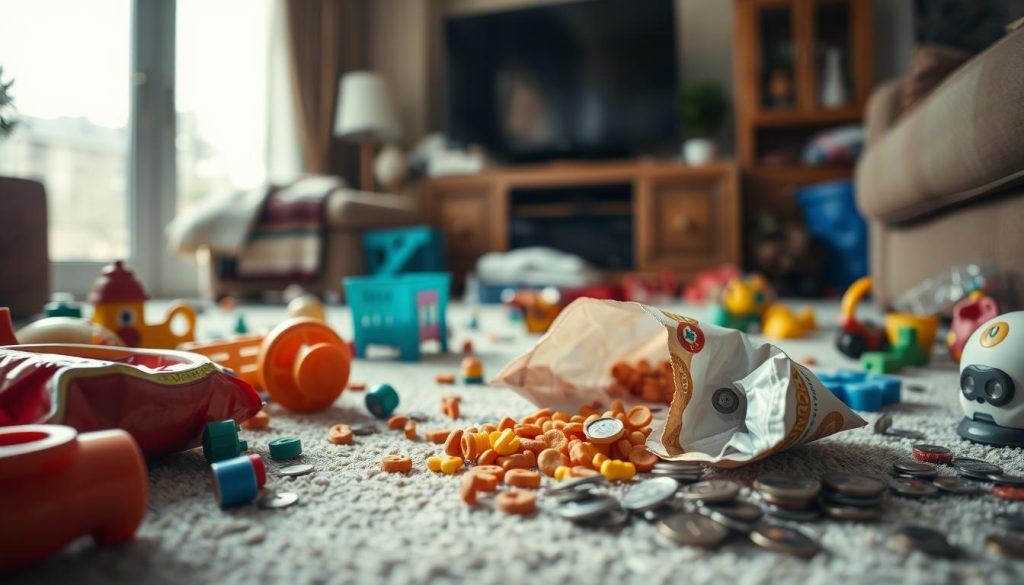
Safety for Infants and Toddlers
Watching over your kids during meals and play is crucial. Also, pick safe, durable toys and objects. Knowing about choking hazards and taking steps can make your home safer for your children.
| Age Group | Choking Hazards | Precautions |
|---|---|---|
| Infants (0-12 months) | Small toys, parts, and objects | Supervise playtime, ensure toys are safe and durable |
| Toddlers (1-3 years) | Foods, small toys, and parts | Supervise mealtime and playtime, ensure toys are safe and durable |
Safe Transportation for Children
As a parent, keeping my child safe while traveling is my main concern. This includes car rides, bike trips, and walks to school. Car seat safety, bicycle safety, and pedestrian safety are key.
For car seat safety, picking the right seat for my child’s age and size is crucial. I must also ensure the seat is installed correctly and my child is buckled up. When biking, my child should wear a helmet and knee pads. Teaching them to be aware of pedestrians is also important.
Car Seat Regulations
Car seat laws differ by state. Most require kids to use a car seat until they’re 8 or 4 feet 9 inches tall. I need to check my state’s rules to follow them.
Bicycle Safety Gear
Wearing helmets and knee pads can prevent injuries when biking. I should also ensure the bike fits my child and teach them safe riding skills.
Pedestrian Awareness
Teaching my child to be careful when walking is vital. They should look both ways before crossing, use crosswalks, and follow traffic signals.
By following these safety tips, I can keep my child safe during travel. Whether in a car, on a bike, or walking, their safety is my priority.
| Transportation Mode | Safety Tips |
|---|---|
| Car | Use a car seat, buckle up, and ensure proper installation |
| Bike | Wear a helmet and knee pads, ride safely, and follow traffic rules |
| Walking | Look both ways before crossing, use crosswalks, and be mindful of traffic signals |
Teaching Kids About Safety
As a parent, teaching kids about safety is key. It helps them develop good habits and make smart choices. Kids’ safety education should start early and continue throughout their lives. By teaching them about dangers, we can prevent accidents and keep them safe.
There are many important safety lessons for kids. Knowing how to call for help in an emergency is crucial. Teaching them to call 911 or reach out to a trusted neighbor is very important. Also, teaching them about stranger danger is vital to keep them safe from harm.
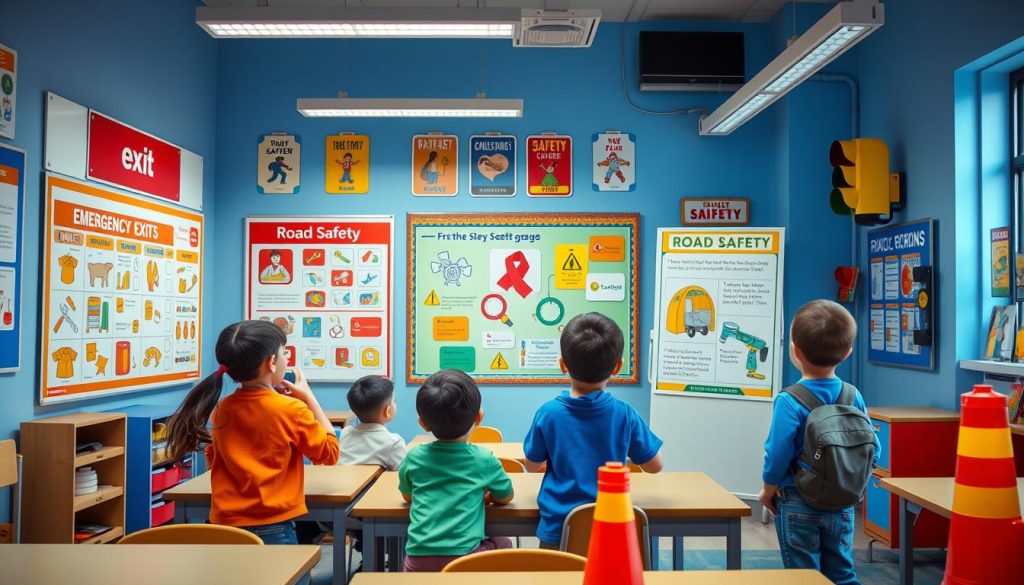
- Stay away from hot surfaces and sharp objects
- Be cautious around strangers and don’t accept anything from them
- Know their emergency contact numbers, such as 911
- Understand basic first aid and what to do in case of an injury
Teaching kids these safety lessons helps them stay aware and make better choices. Remember, teaching kids about safety is a long-term effort. It takes patience, consistency, and practice.
| Safety Topic | Age-Appropriate Lesson |
|---|---|
| Emergency Contact | Teach kids to call 911 and provide their address |
| Stranger Danger | Explain the importance of being cautious around strangers and not accepting anything from them |
| Basic First Aid | Teach kids basic first aid techniques, such as applying bandages and cleaning wounds |
By following these tips and making safety education a priority, we can help our kids stay safe and healthy. Always be patient and consistent when teaching kids about safety. Make it fun and engaging for them.
Promoting Hygiene and Health
As a parent, keeping kids healthy is key. We must teach them good hygiene habits. This makes their environment safe and clean, helping prevent illnesses and allergies.
Teaching kids to wash their hands is a big step. It’s important to wash hands after using the bathroom and before eating. This stops germs from spreading. Also, teach them to cover their mouths when coughing and stay away from sick people.
Safe and Clean Environment
A clean environment is crucial for kids’ health. Clean surfaces often, especially where kids play. This helps stop germs and lowers allergy risks.
Introduction to Handwashing
Handwashing is a must-know hygiene skill. Use soap and water, rub hands well, and rinse well. Making handwashing a habit keeps kids healthy.
Allergy Prevention
Preventing allergies is also important. Avoid common allergens like peanuts and shellfish. Know about any food allergies or sensitivities. This keeps kids safe from allergic reactions.
By focusing on hygiene and health, we teach kids good habits. Kids’ health is our main concern. Together, we can make a safe, healthy space for them to grow.
Encouraging Safe Play
As a parent, it’s key to make a safe play space for our kids. We should pick toys that are right for their age and safe. Also, we need to watch them play to avoid accidents. This way, our kids can grow strong and happy without getting hurt.
Outdoor play is very important for safety. We must make sure our kids wear the right gear like helmets and knee pads. They should play in a safe spot, away from dangers like roads and sharp things. Playing outside is not just fun; it’s also good for their body and mind.
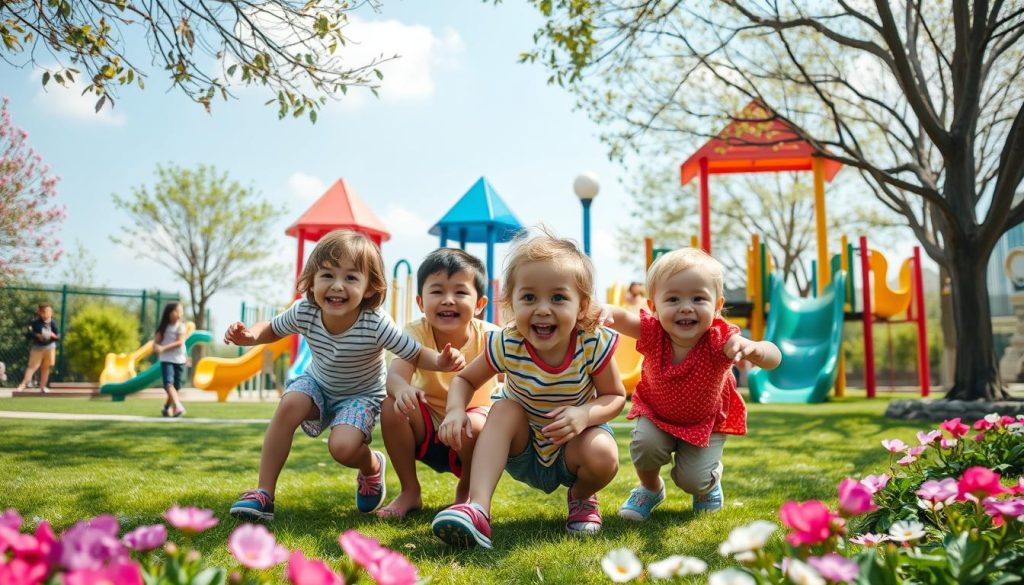
- Choose age-appropriate toys that meet safety standards
- Supervise playtime to prevent accidents
- Ensure outdoor play areas are safe and free from hazards
- Teach our kids about safety rules and regulations
By following these tips, we can make a safe and fun play area for our kids. This lets them grow and have fun without getting hurt. Remember, keeping our kids safe is a team effort. Together, we can give them a happy and healthy childhood.
Regular Home Safety Reviews
As a homeowner, it’s key to check your home’s safety regularly. You can do this by making monthly checklists. These should include tasks like checking smoke detectors and fire extinguishers. This way, you can spot dangers early and fix them before they get worse.
It’s also important to be ready for each season. For example, in winter, make sure your pipes are insulated and have a plan for when the power goes out. In summer, have a plan to stay cool and hydrated.
Engaging Kids in Safety Practices
Getting kids involved in home safety is a great way to teach them. By letting them help, they learn important safety habits. This can be as easy as having them check smoke detectors or help make an emergency plan.
Here are some ways to get kids involved in safety:
- Teach them about potential hazards and how to identify them
- Encourage them to report any hazards they find
- Involve them in creating a emergency plan
- Praise them for their efforts and reinforce good safety habits
By regularly checking your home’s safety and getting kids involved, you make your home safer for everyone. Always remember to focus on home safety, monthly checklists, and being ready for each season to keep your home safe from dangers.
| Season | Safety Tips |
|---|---|
| Winter | Insulate pipes, have a plan for power outages, and keep emergency supplies on hand |
| Summer | Stay cool and hydrated, have a plan for extreme heat, and keep emergency supplies on hand |
Creating a Family Emergency Plan
As we wrap up our discussion on making your home safer for kids, it’s crucial to emphasize the importance of having a well-developed family emergency plan. This plan is your best defense against the unexpected, like natural disasters or other emergencies.
Preparing for natural disasters like earthquakes, hurricanes, or floods is key. By identifying risks and creating a clear plan, your family will know how to act and where to go. Regular communication protocols, like a meeting spot and emergency contacts, keep your family connected and coordinated during a crisis.
The secret to a good family emergency plan is practice. Doing practice drills and scenarios makes your family familiar with the plan. It helps them improve their response and fix any weak spots. This proactive approach is crucial for your family’s safety when disaster hits.

